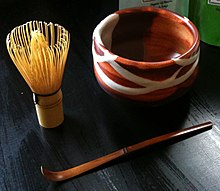 The traditional method of making a cup of tea is to place loose tea leaves, either directly or in a tea infuser, into a tea pot or teacup and pour hot water over the leaves. After a couple of minutes the leaves are usually removed again, either by removing the infuser, or by straining the tea while serving.
The traditional method of making a cup of tea is to place loose tea leaves, either directly or in a tea infuser, into a tea pot or teacup and pour hot water over the leaves. After a couple of minutes the leaves are usually removed again, either by removing the infuser, or by straining the tea while serving.Most green teas should be allowed to steep for about two minutes, although some types of tea require as much as ten minutes, and others as little as thirty seconds. The strength of the tea should be varied by changing the amount of tea leaves used, not by changing the steeping time. The amount of tea to be used per amount of water differs from tea to tea but one basic recipe may be one slightly heaped teaspoon of tea (about 5 ml) for each teacup of water (200–240 ml) (7–8 oz) prepared as above. Stronger teas, such as Assam, to be drunk with milk are often prepared with more leaves, and more delicate high grown teas such as a Darjeeling are prepared with a little less (as the stronger mid-flavors can overwhelm the champagne notes).
The best temperature for brewing tea depends on its type. Teas that have little or no oxidation period, such as a green or white tea, are best brewed at lower temperatures, between 65 and 85 °C (149 and 185 °F), while teas with longer oxidation periods should be brewed at higher temperatures around 100 °C (212 °F). The higher temperatures are required to extract the large, complex, flavorful phenolic molecules found in fermented tea, although boiling the water reduces the amount of dissolved oxygen in the water.
Type | Water Temp. | Steep Time | Infusions |
White Tea | 65 to 70 °C (149 to 158 °F) | 1–2 minutes | 3 |
Yellow Tea | 70 to 75 °C (158 to 167 °F) | 1–2 minutes | 3 |
Green Tea | 75 to 80 °C (167 to 176 °F) | 1–2 minutes | 4-6 |
Oolong Tea | 80 to 85 °C (176 to 185 °F) | 2–3 minutes | 4-6 |
Black Tea | 99 °C (210 °F) | 2–3 minutes | 2-3 |
Pu'er Tea | 95 to 100 °C (203 to 212 °F) | Limitless | Several |
Herbal Tea | 99 °C (210 °F) | 3–6 minutes | Varied |
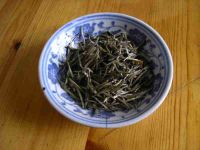 Some tea sorts are often brewed several times using the same tea leaves. Historically, in China, tea is divided into a number of infusions. The first infusion is immediately poured out to wash the tea, and then the second and further infusions are drunk. The third through fifth are nearly always considered the best infusions of tea, although different teas open up differently and may require more infusions of hot water to produce the best flavor.
Some tea sorts are often brewed several times using the same tea leaves. Historically, in China, tea is divided into a number of infusions. The first infusion is immediately poured out to wash the tea, and then the second and further infusions are drunk. The third through fifth are nearly always considered the best infusions of tea, although different teas open up differently and may require more infusions of hot water to produce the best flavor.One way to taste a tea, throughout its entire process, is to add hot water to a cup containing the leaves and after about 30 seconds to taste the tea. As the tea leaves unfold (known as "The Agony of the Leaves") they give up various parts of themselves to the water and thus the taste evolves. Continuing this from the very first flavours to the time beyond which the tea is quite stewed will allow an appreciation of the tea throughout its entire length.
Black tea
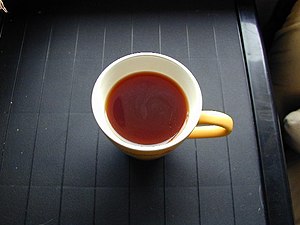 In the West, water for black tea is usually added near boiling point 99 °C (210 °F). Many of the active substances in black tea do not develop at temperatures lower than 90 °C (194 °F). Lower temperatures are used for some more delicate teas. The temperature will have as large an effect on the final flavor as the type of tea used. The most common fault when making black tea is to use water at too low a temperature. Since boiling point drops with increasing altitude, it is difficult to brew black tea properly in mountainous areas. It is also recommended that the teapot be warmed before preparing tea, easily done by adding a small amount of boiling water to the pot, swirling briefly, before discarding.
In the West, water for black tea is usually added near boiling point 99 °C (210 °F). Many of the active substances in black tea do not develop at temperatures lower than 90 °C (194 °F). Lower temperatures are used for some more delicate teas. The temperature will have as large an effect on the final flavor as the type of tea used. The most common fault when making black tea is to use water at too low a temperature. Since boiling point drops with increasing altitude, it is difficult to brew black tea properly in mountainous areas. It is also recommended that the teapot be warmed before preparing tea, easily done by adding a small amount of boiling water to the pot, swirling briefly, before discarding. In the West, black teas are usually brewed for about 4 minutes and are usually not allowed to steep for less than 30 seconds or more than about five minutes (a process known as brewing or mashing in Britain). In many regions of the world, however, boiling water is used and the tea is often stewed. For example, in India black tea is often boiled for fifteen minutes or longer as a strong brew is preferred for making Masala chai. When the tea has brewed long enough to suit the tastes of the drinker, it should be strained while serving. The popular varieties of black (red) tea include Assam tea, Nepal tea, Darjeeling tea, Nilgiri tea, Turkish tea and Ceylon tea.
Green tea
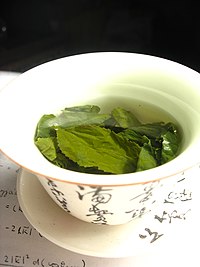 Water for green tea, according to regions of the world that prefer mild tea, should be around 80 to 85 °C (176 to 185 °F); the higher the quality of the leaves, the lower the temperature. Hotter water will produce a bitter taste. However, this is the method used in many regions of the world, such as North Africa or Central Asia where bitter tea is appreciated. For example, in Morocco green tea is steeped in boiling water for fifteen minutes. In the West and Far East a milder tea is appreciated. The container in which the tea is steeped, the mug, or teapot is often warmed beforehand so that the tea does not immediately cool down. High-quality green and white teas can have new water added as many as five or more times, depending on variety, at increasingly high temperatures.
Water for green tea, according to regions of the world that prefer mild tea, should be around 80 to 85 °C (176 to 185 °F); the higher the quality of the leaves, the lower the temperature. Hotter water will produce a bitter taste. However, this is the method used in many regions of the world, such as North Africa or Central Asia where bitter tea is appreciated. For example, in Morocco green tea is steeped in boiling water for fifteen minutes. In the West and Far East a milder tea is appreciated. The container in which the tea is steeped, the mug, or teapot is often warmed beforehand so that the tea does not immediately cool down. High-quality green and white teas can have new water added as many as five or more times, depending on variety, at increasingly high temperatures.Oolong tea
 Oolong teas should be brewed around 90 to 100 °C (194 to 212 °F), and again the brewing vessel should be warmed before pouring in the water. Yixing purple clay teapots are the traditional brewing vessel for oolong tea. For best results use spring water, as the minerals in spring water tend to bring out more flavor in the tea. High quality oolong can be brewed multiple times from the same leaves, and unlike green tea it improves with reuse. It is common to brew the same leaves three to five times, the third steeping usually being the best.
Oolong teas should be brewed around 90 to 100 °C (194 to 212 °F), and again the brewing vessel should be warmed before pouring in the water. Yixing purple clay teapots are the traditional brewing vessel for oolong tea. For best results use spring water, as the minerals in spring water tend to bring out more flavor in the tea. High quality oolong can be brewed multiple times from the same leaves, and unlike green tea it improves with reuse. It is common to brew the same leaves three to five times, the third steeping usually being the best.Premium or delicate tea
 Some teas, especially green teas and delicate Oolong teas, are steeped for shorter periods, sometimes less than 30 seconds. Using a tea strainer separates the leaves from the water at the end of the brewing time if a tea bag is not being used. However, the black Darjeeling tea, a premium Indian tea, needs a longer than average steeping time. Elevation and time of harvest offer varying taste profiles; proper storage and water quality also have a large impact on taste.
Some teas, especially green teas and delicate Oolong teas, are steeped for shorter periods, sometimes less than 30 seconds. Using a tea strainer separates the leaves from the water at the end of the brewing time if a tea bag is not being used. However, the black Darjeeling tea, a premium Indian tea, needs a longer than average steeping time. Elevation and time of harvest offer varying taste profiles; proper storage and water quality also have a large impact on taste.Pu-erh tea
Pu-erh tea is also called Pu'er tea. Pu-erh teas require boiling water for infusion. Some prefer to quickly rinse pu-erh for several seconds with boiling water to remove tea dust which accumulates from the aging process. Infuse pu-erh at the boiling point (100 °C or 212 °F), and allow to steep for 30 seconds or up to five minutes.
Serving
 In order to preserve the pre-tannin tea without requiring it all to be poured into cups, a second teapot may be used. The steeping pot is best unglazed earthenware; Yixing pots are the best known of these, famed for the high quality clay from which they are made. The serving pot is generally porcelain, which retains the heat better. Larger teapots are a post-19th century invention, as tea before this time was very rare and very expensive. Experienced tea-drinkers often insist that the tea should not be stirred around while it is steeping (sometimes called winding in the UK). This, they say, will do little to strengthen the tea, but is likely to bring the tannins out in the same way that brewing too long will do. For the same reason one should not squeeze the last drops out of a teabag; if stronger tea is desired, more tea leaves should be used.
In order to preserve the pre-tannin tea without requiring it all to be poured into cups, a second teapot may be used. The steeping pot is best unglazed earthenware; Yixing pots are the best known of these, famed for the high quality clay from which they are made. The serving pot is generally porcelain, which retains the heat better. Larger teapots are a post-19th century invention, as tea before this time was very rare and very expensive. Experienced tea-drinkers often insist that the tea should not be stirred around while it is steeping (sometimes called winding in the UK). This, they say, will do little to strengthen the tea, but is likely to bring the tannins out in the same way that brewing too long will do. For the same reason one should not squeeze the last drops out of a teabag; if stronger tea is desired, more tea leaves should be used.Additives
The addition of milk to tea in Europe was first mentioned in 1680 by the epistolist Madame de Sévigné. Many teas are traditionally drunk with milk in cultures where dairy products are consumed. These include Indian masala chai, and British tea blends. These teas tend to be very hearty varieties of black tea which can be tasted through the milk, such as Assams, or the East Friesian blend. Milk is thought to neutralize remaining tannins and reduce acidity. The Chinese (Hans) do not usually drink milk with tea (or indeed use milk at all) but the Manchurians do, and the elite of the Qing Dynasty of the Chinese Empire continued to do so. Hong Kong-style milk tea is based on British colonial habits. Tibetans and other Himalayan peoples traditionally drink tea with milk or yak butter and salt. In Eastern European countries as Poland or Hungary people almost invariably have their tea with lemon juice.
A 2007 study published in the European Heart Journal found that certain beneficial effects of tea may be lost through the addition of milk.
 Many flavourings are added to varieties of tea during processing. Among the best known are Chinese Jasmine tea, with jasmine oil or flowers, the spices in Indian Masala chai and Earl Grey tea, which contains oil of bergamot. A great range of modern flavours have been added to these traditional ones.In eastern India people also drink lemon tea or lemon masala tea. Lemon tea simply contains hot tea with lemon juice and sugar. Masala lemon tea contains hot tea with roasted cumin seed powder, lemon juice, black salt and sugar which gives it a tangy, spicy taste.
Many flavourings are added to varieties of tea during processing. Among the best known are Chinese Jasmine tea, with jasmine oil or flowers, the spices in Indian Masala chai and Earl Grey tea, which contains oil of bergamot. A great range of modern flavours have been added to these traditional ones.In eastern India people also drink lemon tea or lemon masala tea. Lemon tea simply contains hot tea with lemon juice and sugar. Masala lemon tea contains hot tea with roasted cumin seed powder, lemon juice, black salt and sugar which gives it a tangy, spicy taste. Other popular additives to tea by the tea-brewer or drinker include sugar, liquid honey or a solid Honey Drop, agave nectar, lemon (traditional in Russia and Italy), fruit jams, and mint. In China sweetening tea was traditionally regarded as a feminine practice. In colder regions such as Mongolia, Tibet and Nepal, butter is added to provide necessary calories. Tibetan butter tea contains rock salt and dre (yak) butter, which is then churned vigorously in a cylindrical vessel closely resembling a butter churn. The same may be said for salt tea, which is consumed in some cultures in the Hindu Kush region of northern Pakistan.
Other popular additives to tea by the tea-brewer or drinker include sugar, liquid honey or a solid Honey Drop, agave nectar, lemon (traditional in Russia and Italy), fruit jams, and mint. In China sweetening tea was traditionally regarded as a feminine practice. In colder regions such as Mongolia, Tibet and Nepal, butter is added to provide necessary calories. Tibetan butter tea contains rock salt and dre (yak) butter, which is then churned vigorously in a cylindrical vessel closely resembling a butter churn. The same may be said for salt tea, which is consumed in some cultures in the Hindu Kush region of northern Pakistan.Alcohol may also be added to tea, such as whisky or brandy.
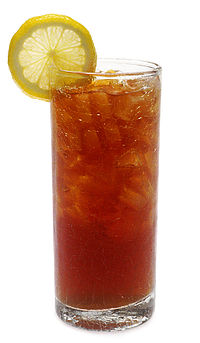 The flavor of the tea can also be altered by pouring it from different heights, resulting in varying degrees of oxidization. The art of high-altitude pouring is used principally by people in Northern Africa (e.g. Morocco and Libya), but also in West Africa (e.g. Guinea, Mali, Senegal) and can positively alter the flavor of the tea, but it is more likely a technique to cool the beverage destined to be consumed immediately. In certain cultures the tea is given different names depending on the height it is poured from. In Mali, gunpowder tea is served in series of three, starting with the highest oxidization or strongest, unsweetened tea (cooked from fresh leaves), locally referred to as "bitter as death," followed by a second serving, where the same tea leaves are boiled again with some sugar added ("pleasant as life"), and a third one, where the same tea leaves are boiled for the third time with yet more sugar added ("sweet as love"). Green tea is the central ingredient of a distinctly Malian custom, the "Grin," an informal social gathering that cuts across social and economic lines, starting in front of family compound gates in the afternoons and extending late into the night, and is widely popular in Bamako and other large urban areas.
The flavor of the tea can also be altered by pouring it from different heights, resulting in varying degrees of oxidization. The art of high-altitude pouring is used principally by people in Northern Africa (e.g. Morocco and Libya), but also in West Africa (e.g. Guinea, Mali, Senegal) and can positively alter the flavor of the tea, but it is more likely a technique to cool the beverage destined to be consumed immediately. In certain cultures the tea is given different names depending on the height it is poured from. In Mali, gunpowder tea is served in series of three, starting with the highest oxidization or strongest, unsweetened tea (cooked from fresh leaves), locally referred to as "bitter as death," followed by a second serving, where the same tea leaves are boiled again with some sugar added ("pleasant as life"), and a third one, where the same tea leaves are boiled for the third time with yet more sugar added ("sweet as love"). Green tea is the central ingredient of a distinctly Malian custom, the "Grin," an informal social gathering that cuts across social and economic lines, starting in front of family compound gates in the afternoons and extending late into the night, and is widely popular in Bamako and other large urban areas. In Southeast Asia, particularly in Malaysia, the practice of pouring tea from a height has been refined further using black tea to which condensed milk is added, poured from a height from one cup to another several times in alternating fashion and in quick succession, to create a tea with entrapped air bubbles creating a frothy "head" in the cup. This beverage, teh tarik, literally, "pulled tea," has a creamier taste than flat milk tea and is extremely popular in the region.
In Southeast Asia, particularly in Malaysia, the practice of pouring tea from a height has been refined further using black tea to which condensed milk is added, poured from a height from one cup to another several times in alternating fashion and in quick succession, to create a tea with entrapped air bubbles creating a frothy "head" in the cup. This beverage, teh tarik, literally, "pulled tea," has a creamier taste than flat milk tea and is extremely popular in the region. Reference: http://en.wikipedia.org/wiki/Tea

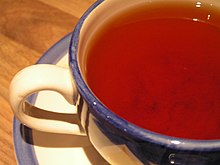
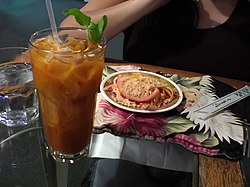







0 comments:
Post a Comment